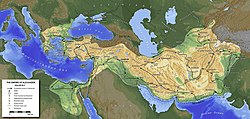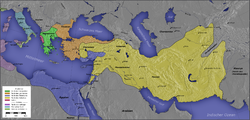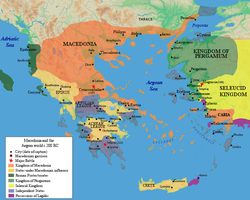Hellenistic period
The Hellenistic period in Ancient Greece (323–146 BC) was the time period between the death of Alexander the Great when the generals of Alexander created their own empires and the Roman conquest of mainland Greece.
During this era: Greek culture, art and power expanded all over the Eastern Mediterranean (including Anatolia, Egypt, the Levant and the Balkans). Of all the Hellenistic empires that were established, the Seleucid Empire was the largest. The Ptolemaic dynasty in Egypt is the most famous and the longest lasting due to its famous Library of Alexandria and members like Cleopatra VII.
Hellenistic Period Media
Papyrus document dated to c.33 BC with the possible handwriting of Cleopatra VII, Queen of Ptolemaic Egypt and the last Hellenistic monarch, who signatured "γινέσθωι" ("make it happen") regarding a royal grant of tax exemptions.
Alexander fighting the Persian king Darius III. From the Alexander Mosaic, Naples National Archaeological Museum.
The distribution of satrapies in the Macedonian Empire after the Settlement in Babylon (323 BC).
Kingdoms of the Diadochi after the battle of Ipsus, c. 301 BC.* Kingdom of Ptolemy I Soter* Kingdom of Cassander* Kingdom of Lysimachus* Kingdom of Seleucus I Nicator
The major Hellenistic kingdoms in 240 BC, including territories controlled by the Seleucid dynasty, the Ptolemaic dynasty, the Attalid dynasty, the Antigonid dynasty, and independent poleis of Hellenistic Greece








